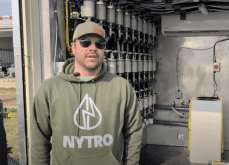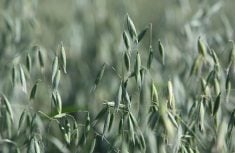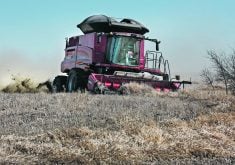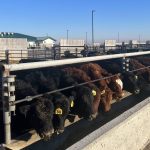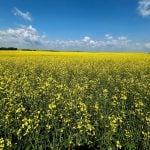Maximizing profit on alfalfa
Harvesting alfalfa at 50 percent bloom produced the highest returns in a three-year study of the relationship between alfalfa cutting stage and economic returns.
Alfalfa is widely grown in Alberta and its on-farm value is estimated at $200 million. The best time to harvest alfalfa varies by location, cultivar and use. Harvesting before bloom normally produces a high protein hay. Earlier cutting also allows more frequent harvests in short growing seasons. However, this management practice comes at a cost of reduced yield, shorter stand life and the increased expense of more frequent harvests.
Read Also

VIDEO: Ag in Motion documentary launches second season
The second season of the the Western Producer’s documentary series about Ag in Motion launched Oct. 8.
An important consideration when deciding when to harvest alfalfa is the end use. For example, export markets have very high specifications for compressed bales, pellets and cubes. Local buyers may also pay a premium for hay that meets particular standards.
Producers have more leeway if they are feeding the forage to their own livestock. The cost of meeting particular standards must be compared with the premium for quality.
Researchers at the Agriculture Canada research centre in Lethbridge are studying the effect of cutting alfalfa at different growth stages on dry matter yield, quality and on the net farm value of alfalfa.
Alfalfa plots were harvested two to four times a year at vegetative, pre-bud, pre-bloom, 10 percent bloom, 50 percent bloom, 90 percent bloom and after a killing fall frost.
Average annual dry matter yields ranged from 6.1 tonnes per ha (2.7 tons per acre) at the vegetative stage (four cuts) to 10.1 tonnes per ha (4.5 tons/ac) at 50 percent bloom (three cuts). Depending on the harvest regime, the first cut contributed between 26 and 54 percent to total dry matter yield.
On a dry matter basis, weed growth in the pre-bud cutting treatment was about 21Ú2 times that of the 50 percent bloom treatment.
Analysis confirmed recommendations that alfalfa hay be harvested at the 10 percent to 50 percent bloom stage. With no price premium for quality, harvesting alfalfa at the 50 percent bloom stage resulted in the highest average returns per hectare. Cutting earlier requires a premium of about $6 per tonne at the pre-bloom stage and $24 per tonne at the pre-bud stage to compensate for lower yields.
The study is scheduled to continue for three more years.
– Agriculture Canada



